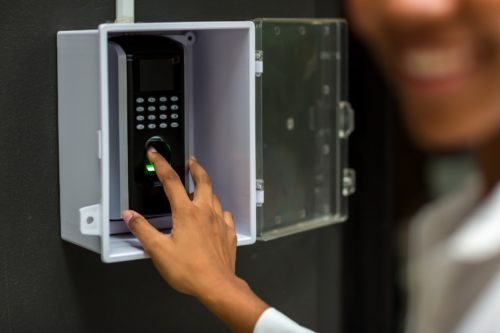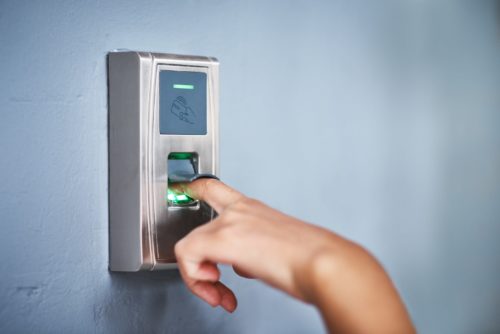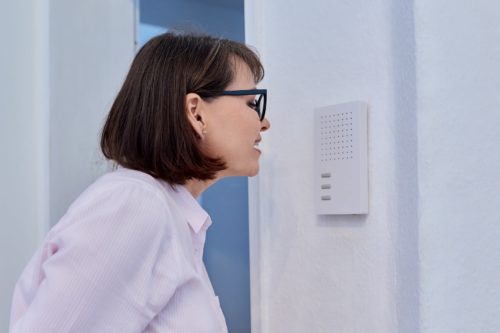Biometric access control has become a valuable tool for businesses looking to enhance protection for their assets, staff, and data.
Unlike traditional access methods, which rely on items that can be lost, stolen, or duplicated, biometric systems use unique physical traits—such as fingerprints or facial features—to grant entry, providing an advanced level of security and accuracy.
Biometric access control systems are particularly effective for businesses that handle sensitive information or have high-security requirements, as they offer precise identification that’s difficult to forge or bypass.
At BES Security, we specialise in implementing robust access control solutions, tailored to meet the unique needs of your business.

What is a Biometric Access Control System?
A biometric access control system is a security solution that grants access based on unique, measurable characteristics of an individual.
Rather than relying on physical keys, cards, or PINs, biometric systems use identifiers like fingerprints, facial features, iris patterns, or even voice to confirm a person’s identity.
This process is highly secure, as biometric traits are unique to each person and nearly impossible to replicate.
Biometric systems are commonly used in environments that demand high security, such as corporate offices, research labs, healthcare facilities, and government buildings.
By verifying identity based on physical attributes, biometric access control reduces the risk of unauthorised entry and provides a highly reliable means of managing access.
How Biometric Authentication Works
Biometric authentication begins by capturing and storing a user’s unique physical data during an initial setup, known as the ‘enrollment’ process.
During enrollment, the system scans the selected biometric trait—such as a fingerprint or facial structure—and converts it into a digital template that is stored securely within the system’s database. This template acts as a reference for future verification.
When the user attempts to access a restricted area, the system captures their biometric data once again and compares it to the stored template.
If the captured data matches the template, the system grants access. Advanced biometric technology ensures this process is fast and accurate, with minimal risk of false matches.
Since each individual’s biometric data is unique, biometric systems provide a reliable and tamper-resistant way of securing entry points.
Biometric authentication relies on sophisticated software and hardware that allow for rapid and precise matching. Whether through fingerprint sensors, facial recognition cameras, or iris scanners, these systems are designed to provide accurate verification even in high-traffic or complex environments.
This advanced technology not only strengthens security but also reduces the chances of unauthorised access, making biometric systems an excellent choice for businesses focused on protecting sensitive areas.
Key Benefits of a Biometric Access Control System
Enhanced Security with Unique Identifiers
Biometric access control systems offer an unparalleled level of security by using unique identifiers that are specific to each individual. Unlike traditional access methods—such as keys, cards, or PIN codes—that can be shared, lost, or stolen, biometric traits are inherently unique and difficult to replicate.
Fingerprints, facial structures, and iris patterns are not easily forged, making biometric systems an effective safeguard against unauthorised access.
By eliminating reliance on physical items or passwords, biometric access systems significantly reduce the risk of unauthorised entry. With biometric data, businesses can rest assured that only the right person can gain entry to restricted areas, offering a level of security that surpasses traditional access control methods.
This added layer of protection is especially valuable in high-security environments where sensitive data or valuable assets are stored.
Accuracy and Reliability
The accuracy of biometric systems is one of their most notable advantages. Biometric access systems verify individuals using precise physical characteristics, minimising the chances of errors. Advanced algorithms and high-quality sensors ensure that each scan provides reliable results, making it difficult for unauthorised users to gain access.
Biometric systems are designed to minimise false positives (incorrectly granting access) and false negatives (denying access to authorised users), providing consistent and reliable authentication.
This reliability is crucial for environments where security is a top priority, such as financial institutions, data centres, and government buildings. The dependable nature of biometric access control systems makes them ideal for businesses looking to protect sensitive or high-stakes environments.
Convenience and Efficiency
Biometric access systems offer a high level of convenience, allowing users to enter secure areas quickly without needing to carry access cards or remember PIN codes.
With just a scan of their fingerprint or facial recognition, authorised users can gain access, streamlining the entry process and reducing delays.
This convenience is especially beneficial in high-traffic areas, where traditional methods can lead to bottlenecks. Biometric systems not only enhance security but also improve efficiency, enabling smooth entry and reducing wait times.
For businesses, this means increased productivity and a more seamless experience for employees and visitors alike.
Enhanced Monitoring and Data Tracking
Biometric access control systems provide businesses with comprehensive tracking and monitoring capabilities, logging each entry attempt with specific details.
This data can include who accessed which areas and at what times, offering valuable insights into access patterns and providing an audit trail for security purposes.
Detailed logs are essential for security audits, investigations, and ensuring compliance with regulatory requirements.
By providing precise records of access, biometric systems enable businesses to maintain full visibility of entry points, strengthen accountability, and streamline the process of identifying potential security breaches.
Long-Term Cost-Effectiveness
While biometric access systems may involve higher upfront costs compared to traditional methods, they provide significant long-term savings.
With biometric authentication, there’s no need to constantly replace lost or stolen keys or cards, and businesses avoid the administrative costs of managing these traditional methods.
The secure nature of biometric data reduces the risk of unauthorised access, ultimately lowering the potential for security breaches and associated costs.
Biometric systems are also known for their durability and low maintenance, making them a cost-effective choice over time.
With fewer moving parts and a focus on digital access, these systems typically require minimal repairs or replacements, allowing businesses to benefit from enhanced security and long-term savings.
Types of Biometric Access Control Technologies
Fingerprint Access Control
Fingerprint access control systems are among the most widely used biometric solutions, leveraging the unique patterns on an individual’s fingertip to verify their identity.
During setup, the system scans and stores the user’s fingerprint as a digital template. When the user attempts to gain access, the system scans their fingerprint again and matches it to the stored data, granting entry if it detects a match.
Fingerprint systems are popular due to their ease of use and high level of security, making them ideal for a range of business environments. They offer quick, touch-based authentication that’s highly accurate, ensuring secure access without the need for additional devices or codes.
The simplicity and security of fingerprint access control make it well-suited for offices, healthcare facilities, and other workplaces where secure, fast access is essential.

Facial Recognition Access Control
Facial recognition access systems work by capturing a digital image of an individual’s face and analysing unique facial features, such as the distance between eyes or the shape of the jawline, to confirm identity.
This data is converted into a digital map, which is then stored and used as a reference for future access attempts.
Facial recognition is particularly useful in environments with high foot traffic or where hands-free access is preferred, such as corporate offices, airports, or large retail centres. Since users only need to look at a camera to gain entry, it provides an efficient, non-contact way of managing access.
This convenience, combined with high accuracy, makes facial recognition a suitable choice for busy locations where swift, secure entry is essential.

Iris and Retina Scanning
Iris and retina scanning technologies offer some of the highest levels of accuracy in biometric access control. Iris scanning focuses on capturing the unique patterns in the coloured part of the eye (iris), while retina scanning maps the unique blood vessel patterns in the back of the eye.
Both methods create a secure, intricate biometric signature that is nearly impossible to duplicate.
Due to their high level of precision, iris and retina scanning are often reserved for high-security settings, such as government facilities, military bases, and research labs.
These systems ensure that only authorised personnel with verified credentials can access sensitive areas, providing unparalleled protection for businesses that handle classified information or valuable assets.

Voice Recognition Access Control
Voice recognition access control systems authenticate users by analysing their vocal characteristics. Each person’s voice has unique traits—such as pitch, tone, and pronunciation—that can be captured and stored as a digital template.
During each access attempt, the system matches the spoken input with the stored voice data to confirm identity.
Voice recognition is especially useful in hands-free environments, such as healthcare facilities or manufacturing plants, where employees may need quick access without handling additional devices.
It’s also a practical alternative for individuals who may find other biometric methods challenging, such as those with physical limitations that affect fingerprint or facial recognition. While not as widely used as fingerprint or facial recognition, voice recognition offers a convenient and secure option for specific settings.

Comparing Biometric Access Control to Other Access Methods
Biometric Access vs. Card/Fob Access
Compared to traditional card or fob systems, biometric access offers a significantly higher level of security by verifying unique physical traits rather than relying on possession of a device.
Cards and fobs can be easily lost, stolen, or duplicated, creating potential security vulnerabilities. In contrast, biometric systems authenticate individuals based on unique identifiers, making unauthorised access far more difficult.
In addition, biometric access eliminates the need for frequent replacements of lost or damaged cards, which can lead to significant cost savings.
For businesses looking to minimise security risks and administrative expenses, biometric access control provides a robust, reliable alternative to card or fob systems.
Biometric Access vs. Keypad Access
Biometric systems also offer clear advantages over keypad access. Keypads require users to remember and enter codes, which can be forgotten or shared, potentially compromising security.
In contrast, biometric access is quick and precise, allowing for faster authentication without the risk of shared or lost access codes.
The added protection of biometric traits ensures that only authorised individuals can enter secure areas, as physical characteristics are much harder to replicate or compromise than numeric codes.
For businesses seeking both security and convenience, biometric access control provides a more effective solution than keypad entry, especially in high-security or high-traffic areas.
Biometric Access Control System FAQs
What is a biometric access control system?
A biometric access control system is a security solution that uses an individual’s unique physical characteristics—such as fingerprints, facial features, or iris patterns—to verify their identity and grant access.
By relying on these personal identifiers, biometric systems offer a secure and efficient way to control entry, reducing the risks associated with traditional access methods like keys, cards, or PIN codes.
How does biometric access control work?
Biometric access control systems operate by capturing and storing a digital template of an individual’s biometric data during an initial setup, known as enrollment. When a user attempts to access a secure area, the system scans their physical trait—such as their fingerprint or face—and compares it to the stored template.
If the captured data matches, access is granted. This process ensures that only authorised individuals can gain entry, adding a robust layer of security.
What are the main advantages of biometric access control?
Biometric access control offers several key benefits:
- Enhanced Security: Biometric traits are unique and difficult to forge, providing strong protection against unauthorised access.
- High Accuracy: Advanced technology minimises false positives and negatives, ensuring reliable identity verification.
- Convenience: Users don’t need to carry cards or remember codes, making access faster and simpler.
Is biometric access control safe for all types of businesses?
While biometric access control is especially suitable for businesses handling sensitive data or requiring high security—such as government facilities, healthcare institutions, and financial organisations—it can benefit many types of businesses.
From offices to educational institutions, biometric systems provide an added layer of security and convenience, making them a versatile solution for a wide range of industries.
How accurate is biometric authentication?
Biometric authentication is highly accurate due to its reliance on unique physical characteristics. With advanced algorithms and technology, biometric systems are designed to minimise false positives (granting access to unauthorised users) and false negatives (denying access to authorised users).
This high level of accuracy makes biometrics particularly suitable for environments where security is critical.
Are there privacy concerns with biometric data?
Privacy is an essential consideration with biometric access control, as it involves sensitive personal information. To protect users’ privacy, biometric data must be securely stored and managed in compliance with relevant privacy regulations, such as GDPR.
Businesses must implement encryption and secure data storage practices to safeguard biometric data, ensuring that individuals’ privacy is respected and maintained.
Biometric Access Control Systems at BES Security
Biometric access control systems provide a powerful combination of enhanced security, accuracy, and convenience, making them a highly effective choice for businesses aiming to strengthen their access management.
By using unique physical traits for authentication, biometric systems reduce the risks of unauthorised entry and improve the ease of access for authorised users.
For businesses interested in implementing or upgrading to biometric access control, BES Security offers expert guidance and tailored solutions to meet unique security needs.
To learn more, consult BES Security’s Access Control page for further details on our access control offerings and support in choosing the right system for your business.


